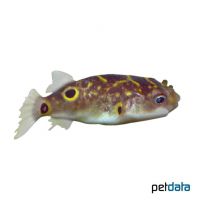Eyespot Pufferfish (Dichotomyctere ocellatus)
| Eyespot Pufferfish Dichotomyctere ocellatus | |
|---|---|
| Name | Eyespot Pufferfish |
| Name Lat. | Dichotomyctere ocellatus |
| Synonym | Tetraodon biocellatus |
| Family | Puffers |
| Family lat. | Tetraodontidae |
| Order | Puffers & Filefishes |
| Order lat. | Tetraodontiformes |
| Origin | Southeast Asia |
| Habitat | Streams, rivers |
| Diet | Carnivore |
| pH | 6.5-7.5 |
| Behavior | Semi-aggressive |
| Keeping | Individual, group |
| Care Level | Difficult |
| Reproduction | Egg scatterer |
| Breeding | None reported |
| Life Span | 8-10 years |
| Protection | No |
| Metric Units | |
| Size | 6-8 cm |
| Temperature | 22-26 °C |
| Hardness | 5-20 °dH |
| Aquarium | ~ 200 l |
| US Units | |
| Size | 2.4"-3" |
| Temperature | 72-79 °F |
| Hardness | 89-356 ppm |
| Aquarium | ~ 50 gal |
Distribution and habitat
The distribution area of the Eye Spot Pufferfish is Cambodia, Malaysia and Indonesia. There they live mainly in the freshwater of coastal, slow-flowing waters with dense underwater vegetation, but also occur in the brackish water of estuaries.
Maintenance
They need an aquarium with dense border and background planting, with branched roots as hiding places as well as sufficient swimming space. A fine sandy substrate, subdued light (floating plants) and medium hard, slightly alkaline water is ideal.
No ammonia, ammonium and nitrite should be detectable, the nitrate value should not exceed 100 mg/l. To ensure the water quality and oxygen content, a filter and heater adapted to the aquarium size is required, as well as lighting for the species-appropriate day-night rhythm of the animals.
Diet
They are food specialists, eating almost exclusively crustaceans and snails. They also need the hard shells to wear down their teeth. The food supply consists of live snails as well as shrimps, crayfish, red mosquito larvae, artemia and mysis, which is also easily accepted frozen, supplemented with small mussels and mussel meat. Rarely flake or granulated food is accepted.
It is recommended to feed small portions several times a day, which are eaten within a few minutes. A regular and varied diet promotes health and increases resistance.
Behaviour and compatibility
They behave intra-species territorial, therefore several animals should be maintained only in large and richly structured tanks. They can be well socialized with other, not too small fish. Caution is advised with long finned fish, as they tend to fin pluck.
Basically, only compatible fish species with similar demands on water condition and water temperature should be socialized.
Sex dimorphism
The sexes are difficult to distinguish. The females grow larger and are stockier than the males.
Reproduction and breeding
There are no known reports of successful breeding in the aquarium.
Important
Eye spot puffers can be kept well in freshwater. However, soft water is not well tolerated and makes them susceptible to disease. For water hardening, the addition of 2-10 g sea salt (mineral salt) per liter of water from the pet store is recommended.
When threatened, they can inflate to 2-3 times their size by filling their elastic stomach with air or water
A cup filled with aquarium water should be used for transferring or placing the animals so that they do not become airborne.
The well-being of the fish should be checked regularly. Temperature should be checked daily, pH, hardness and nitrate levels should be checked at least every 14 days. Regular partial water changes are recommended, even if the contaminant level has not yet reached the upper limit. Sudden changes in water quality should be avoided. Newly introduced fish must be accustomed slowly to the water in the aquarium.
Further literature can be found in your pet store.
References
Text: Werner Winter; Image: petdata
Source: BMEL (1998): Tierschutzgutachten - Haltung von Zierfischen (Süßwasser); RIEHL & BAENSCH (2006): Aquarien Atlas Bd. 1, Mergus Verlag; ENGELMANN (2005): Zootierhaltung - Tiere in menschlicher Obhut: Fische, Verlag Harri Deutsch
- Gemäß § 21 Abs. 5 Tierschutzgesetz idgF
